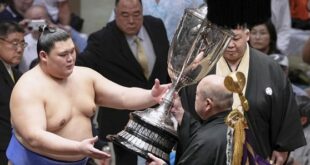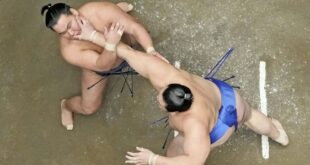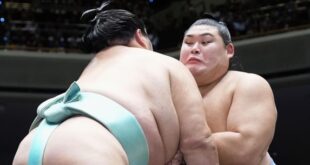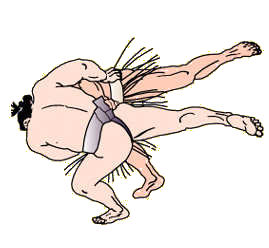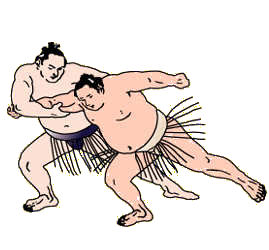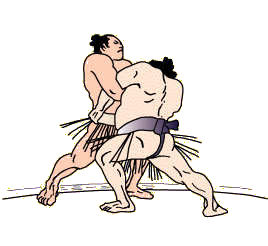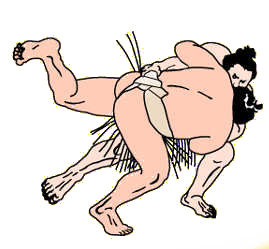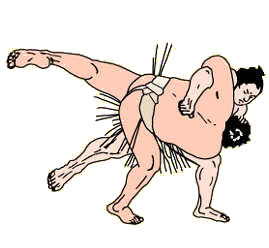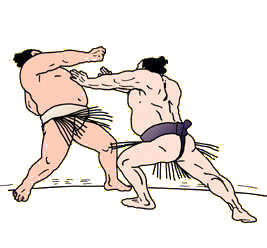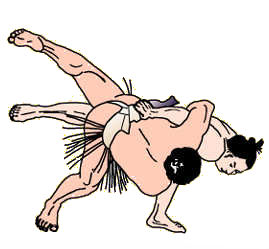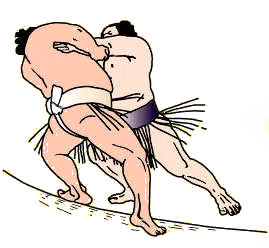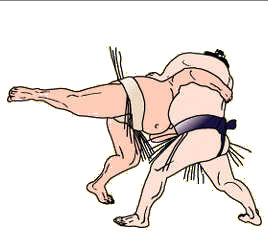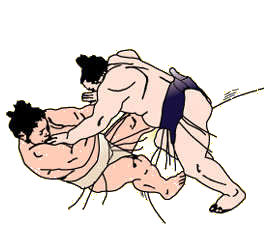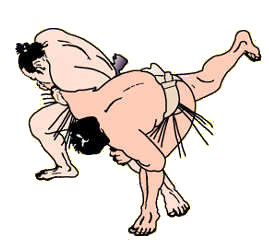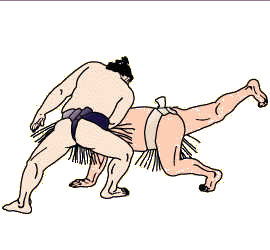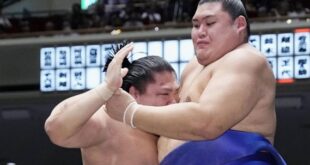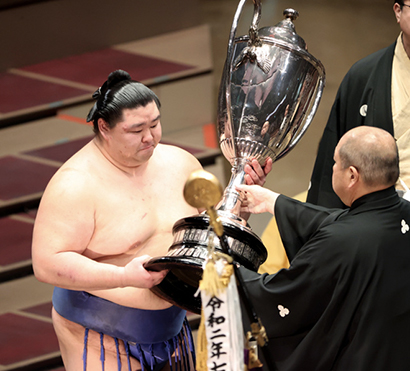
Double récompense pour Shodai
Le titre de vainqueur du tournoi de Septembre s’est joué à l’avant dernier combat de la dernière journée, aujourd’hui. Après un tournoi exemplaire, deux rikishi s’affrontaient pour se départager : l’étonnant maegashira Tobizaru, 1er bashô en makuuchi et donc jeune débutant dans cette catégorie, contre le sekiwake Shodai. Tous les deux alignaient un palmarès éloquent, 11 victoires pour le « rookie » et 12 victoires pour son aîné sur 15 combats, et une volonté farouche de brandir la coupe de l’Empereur. Derrière eux, seul le grand champion ôzeki Takakeishô était en mesure de les concurrencer, à condition que Shodai perde son combat.
Comme toujours, Tobizaru lança le combat sur un mode très dynamique, laissant Shodai un tout petit peu sur la défensive et acculé au bord du cercle sacré. Mais le sekiwake attendait l’occasion qui n’a pas tardé à se présenter : dans l’incapacité de fixer son adversaire et d’attraper son mawashi, Shodai se désaxa lors d’une attaque de Tobizaru pour le faire passer à son côté et le faire chuter à terre par une pression derrière l’épaule.
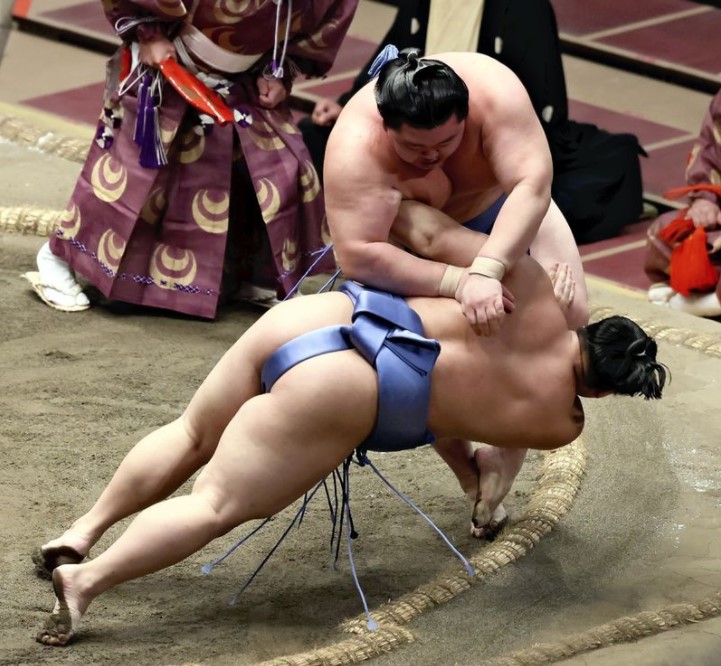
Une victoire éclatante pour un Shodai qui, comme à l’habitude, n’a pas beaucoup exprimé ses émotions, au contraire du maegashira qui a eu de la peine à retenir ses larmes : « C’était la première fois que je rencontrais (Tobizaru) et c’était en fait très difficile pour moi. Je pense que j’ai peut-être été le plus nerveux dans ma carrière de sumo. En janvier et aussi en juillet, je me suis approché du titre mais j’ai échoué. Mais je pense que ces expériences m’ont vraiment aidé à gagner cette fois. »
Le titre et la coupe de l’Empereur sont donc revenus à Shodai pour la première fois, mais il a été aussi récompensé de deux autres prix : le premier shukun-shô dans sa carrière, « prix de la meilleure performance », et un sixième Kantô shô, « Meilleur Esprit Combatif ».
Et ce n’était pas fini !! Quelques temps plus tard, la Nihon Sumo Kyokai, l’Association Japonaise du Sumô, décidait d’accorder à Shodai le titre d’ôzeki pour ses excellents résultats sur les derniers tournois . Bien qu’il n’ait pas atteint la limite des 33 victoires sur les trois derniers tournois, le yushô d’aujourd’hui a emporté leur adhésion finale.
Septembre 2020 : 13-2
Juillet 2020 : 11-4
Mars 2020 : 8-7
Janvier 2020 : 13-2
Novembre 2019 : 11-4
Avant l’annonce, le nouvel ôzeki avait déclaré : « Le rang d’Ôzeki est définitivement quelque chose que j’aspirais à devenir. Je pense que c’est l’objectif de tout rikishi. L’idée que je pourrais atteindre ce rang est inimaginable. »
« Je veux vraiment continuer à gagner. Je veux être sûr que les gens ne pensent pas que c’était juste un hasard », a-t-il ensuite déclaré.
De son côté, Tobizaru a aussi obtenu son premier Kantô shô du « Meilleur Esprit Combatif ».
Le dernier combat du tournoi a donc été sans enjeu pour les deux ôzeki Asanoyama et Takakeishô qui s’affrontaient. Pourtant, ils y ont mis toute leur énergie, principalement Takakeishô qui a réussi à renverser son collègue ôzeki d’une poussée frontale bien groupée et concentrée sur l’expulsion de son adversaire. Bon tournoi des deux rikishi qui ont tenu leur rang en l’absence des deux grands champions yokozuna, Hakuhô et Kakuryu.
Bon final aussi du maegashira 8 Wakatakakage qui atteint sa 11ème victoire, et du maegashira 6 Takayasu, ex-ôzeki, qui finit à10 victoires en compagnie d’Onoshô, autre héros du tournoi.
Grosse descente en vue et peut-être intai (retraite professionnelle) pour un autre ex-ôzeki, Kotoshogiku.
En catégorie juryô, le vainqueur du tournoi était déjà connu hier, avec l’excellent parcours de Chiyonokuni (J11) qui a obtenu aujourd’hui sa 14ème victoire, devançant ainsi son premier poursuivant de 3 longueurs.
Les lutteurs kachi koshi du jour sont :
Jûryô : Hakuyozan
Les lutteurs make koshi du jour sont :
Jûryô : Nishikifuji
Clic on the title bellow for article in English :
Shodai clinches 1st-ever title, ozeki promotion
Sekiwake Shodai withstood a spirited challenge from rookie Tobizaru at the Autumn Grand Sumo Tournament on Sunday to claim his first top-division championship and a promotion to ozeki.
With grand champions Hakuho and Kakuryu missing the entire 15-day tourney through injury, the 28-year-old Shodai took control of the title race with back-to-back wins over ozeki Takakeisho and Asanoyama on Friday and Saturday, respectively. The Kumamoto Prefecture native avoided a playoff on the final day at Ryogoku Kokugikan by improving to an unassailable 13-2 in the penultimate bout against No. 14 maegashira Tobizaru, who came in trailing by one win.
The 28-year-old Tobizaru was aiming to become the first wrestler in more than a century to win the Emperor’s Cup in his makuuchi debut. His impressive 12-3 performance at the tournament garnered him a Fighting Spirit Prize. With an improbable championship at stake, Tobizaru took the battle to Shodai, forcing him back to the straw from the opening charge. Shodai kept his feet on the straw bales and drove the battle back to the middle, but after being forced to the opposite edge of the ring by Tobizaru, he thrusted the maegashira down while just staying inside.
« It was my first time to meet (Tobizaru) and it was actually very difficult for me. I think I may have been the most nervous I’ve ever been in my sumo career, » said Shodai, who was in contention at two previous grand tournaments before fading out late.
« In January and also July I came close but failed. But I think those experiences really helped me win this time. »
Along with the Emperor’s Cup, Shodai earned his first Outstanding Performance Prize and his sixth Fighting Spirit Prize. But the announcement of an even bigger prize, promotion to sumo’s second-highest rank, came later.
« (Ozeki is) definitely something that I aspired to be. I think it’s something every rikishi wants, » he said prior to the announcement. « The idea that I might achieve that rank is unimaginable. »
Tobizaru said the experience was « the most fun I’ve had in a tournament. »
« I really want to continue (winning). I want to make sure people don’t think this was just a fluke, » he said.
Takakeisho overpowered fellow ozeki Asanoyama in the tournament’s final bout to improve to 12-3 and finish one win off the pace. Opening with his trademark thrusting attack, Takakeisho denied Asanoyama (10-5) the leverage for a throw before pushing him down to the clay.
Sekiwake Daieisho finished with a 5-10 record after thrusting down komusubi Okinoumi (4-11).
No. 1 Takanosho (10-5) pushed out No. 7 Aoiyama (7-8) to clinch double-digit wins and ensure promotion to the three elite « sanyaku » ranks below yokozuna for the November grand tournament.
No. 5 Kiribayama (9-4-2) capped off a gritty performance at the tournament by forcing out sekiwake Mitakeumi (9-7). The 24-year-old Mongolian, who missed three bouts with an injured shoulder, withstood a powerful drive from the sekiwake before lifting him over the straw.
With a winning record at stake, No. 10 Kotoeko (8-7) forced out No. 5 Takarafuji (7-8). The Sadogatake stable grappler ended the tournament with three straight victories to claim his crucial eighth win.
No. 6 Kagayaki also improved to 8-7 by throwing No. 12 Kaisei (7-8) to the clay and denying him a winning record.
Source : Kyodo
Champions par division :
Makuuchi : Shodai (13-2)
Sekiwake – Tokitsukaze beya
Jûryô : Chiyonokuni (14-1)
Ouest 11 – Kokonoe beya
Makushita : Terasawa (7-0)
Est 42 – Takasago beya
Sandanme : Hokutenkai (7-0)
Est 20 – Onoe beya
Jonidan : Hokuseiho (7-0)
Ouest 14 – Miyagino beya
Jonokuchi : Hisanotora (7-0)
Ouest 5– Dewanoumi beya
Prix spéciaux (sanshô) :
Shukun-shô : Shodai(1er)
Performance exceptionnelle
Kantô-shô : Shodai (6e), Tobizaru (1er)
Meilleur esprit combatif
Ginô-shô : non attribué
Prix de la technique
- Parution du banzuke : 26 Octobre
- Début du tournoi : 6 Novembre
- Fin du tournoi : 22 Novembre
Lieu : Tokyo (Ryogoku Kokugikan)
(originellement organisé à Fukuoka, le tournoi a été déplacé à Tokyô pour cause de COVID19)
Merci à tous d’avoir suivi le tournoi jour après jour sur Dosukoi mais l’actualité du sumo continue même en dehors des basho. Toutes les informations des événements à venir sont sur notre site. N’oubliez pas de nous rejoindre sur les réseaux sociaux, suivez-nous sur Facebook et Twitter et abonnez-vous à notre chaîne YouTube. N’hésitez pas à partager les articles sur ces réseaux et à les commenter.
Enfin, merci à Sumo Natto et Kintamayama pour leurs vidéos quotidiennes ainsi qu’à tous nos lecteurs.
- Makuuchi
- Juryô
|
Rikishis
|
Score
|
Kimarites
|
Score
|
Rikishis
|
 Ichinojo
逸ノ城 (Maegashira 17) |
|
|
|
|
 Chiyonoo
千代ノ皇 (Juryo 6) |
|
 Ikioi
勢 (Juryo 1) |
|
|
|
|
 Shôhôzan
松鳳山 (Maegashira 15) |
|
 Sadanoumi
佐田の海 (Maegashira 10) |
|
|
|
|
 Hoshoryu
遠藤 (Maegashira 16) |
|
 Shimanoumi
志摩ノ海 (Maegashira 15) |
|
|
|
|
 Wakatakakage
若隆景 (Maegashira 8) |
|
 Tokushoryu
徳勝龍 (Maegashira 8) |
|
|
|
|
 Onosho
阿武咲 (Maegashira 9) |
|
 Ryuden
竜電 (Maegashira 7) |
|
|
|
|
 Ishiura
石浦 (Maegashira 13) |
|
 Kaisei
魁聖 (Maegashira 12) |
|
|
|
|
 Kagayaki
輝 (Maegashira 6) |
|
 Takayasu
高安 (Maegashira 6) |
|
|
|
|
 Meisei
明生 (Maegashira 13) |
|
 Kotoeko
琴恵光 (Maegashira 10) |
|
|
|
|
 Takarafuji
宝富士 (Maegashira 5) |
|
 Kotoshôgiku
琴奨菊 (Maegashira 11) |
|
|
|
|
 Terutsuyoshi
照強 (Maegashira 3) |
|
 Myogiryu
妙義龍 (Maegashira 3) |
|
|
|
|
 Enho
炎鵬 (Maegashira 9) |
|
 Kotoshoho
琴勝峰 (Maegashira 12) |
|
|
|
|
 Tamawashi
玉鷲 (Maegashira 2) |
|
 |
|
|
|
|
 Tochinoshin
栃ノ心 (Maegashira 4) |
|
 Aoiyama
碧山 (Maegashira 7) |
|
|
|
|
 Takanosho
隆の勝 (Maegashira 1) |
|
 Daieisho
大栄翔 (Sekiwake) |
|
|
|
|
 Okinoumi
隠岐の海 (Komusubi) |
|
 Kiribayama
貴ノ富士 (Maegashira 5) |
|
|
|
|
 |
|
 Shodai
正代 (Sekiwake) |
|
|
|
|
 Tobizaru
翔猿 (Maegashira 14) |
|
 Asanoyama
朝乃山 (Ozeki) |
|
|
|
|
 |
|
Rikishis
|
Score
|
Kimarites
|
Score
|
Rikishis
|
 Ura
(Makushita 5) |
|
|
|
|
 Daishoho
大翔鵬 (Juryo 12) |
|
 Mitoryu
水戸龍 (Juryo 8) |
|
|
|
|
 Midorifuji
翠富士 (Juryo 10) |
|
 Akiseyama
明瀬山 (Juryo 10) |
|
|
|
|
 Akua
天空海 (Juryo 6) |
|
 Hakuyozan
白鷹山 (Juryo 11) |
|
|
|
|
 Kyokushuho
旭秀鵬 (Juryo 5) |
|
 Daishomaru
大翔丸 (Juryo 5) |
|
|
|
|
 Chiyonokuni
千代の国 (Juryo 11) |
|
 Churanoumi
美ノ海 (Juryo 7) |
|
|
|
|
 Daiamami
大奄美 (Juryo 4) |
|
 Chiyoshoma
千代翔馬 (Juryo 4) |
|
|
|
|
 Nishikifuji
錦富士 (Juryo 13) |
|
 Oki
王輝 (Juryo 13) |
|
|
|
|
 Chiyomaru
千代丸 (Juryo 3) |
|
 Wakamotoharu
(Juryo 3) |
|
|
|
|
 Tsurugisho
剣翔 (Juryo 8) |
|
 Chiyootori
千代鳳 (Juryo 9) |
|
|
|
|
 Kotonowaka
琴ノ若 (Juryo 2) |
|
 Kotoyuki
琴勇輝 (Juryo 2) |
|
|
|
|
 Hidenoumi
英乃海 (Juryo 9) |
|
 Kitaharima
北磻磨 (Juryo 14) |
|
|
|
|
 Nishikigi
錦木 (Juryo 1) |
 Dosukoi, le site du sumo Sumo : actualités, résultats, dossiers, vidéos… toute la passion du sumo est sur Dosukoi!
Dosukoi, le site du sumo Sumo : actualités, résultats, dossiers, vidéos… toute la passion du sumo est sur Dosukoi!
